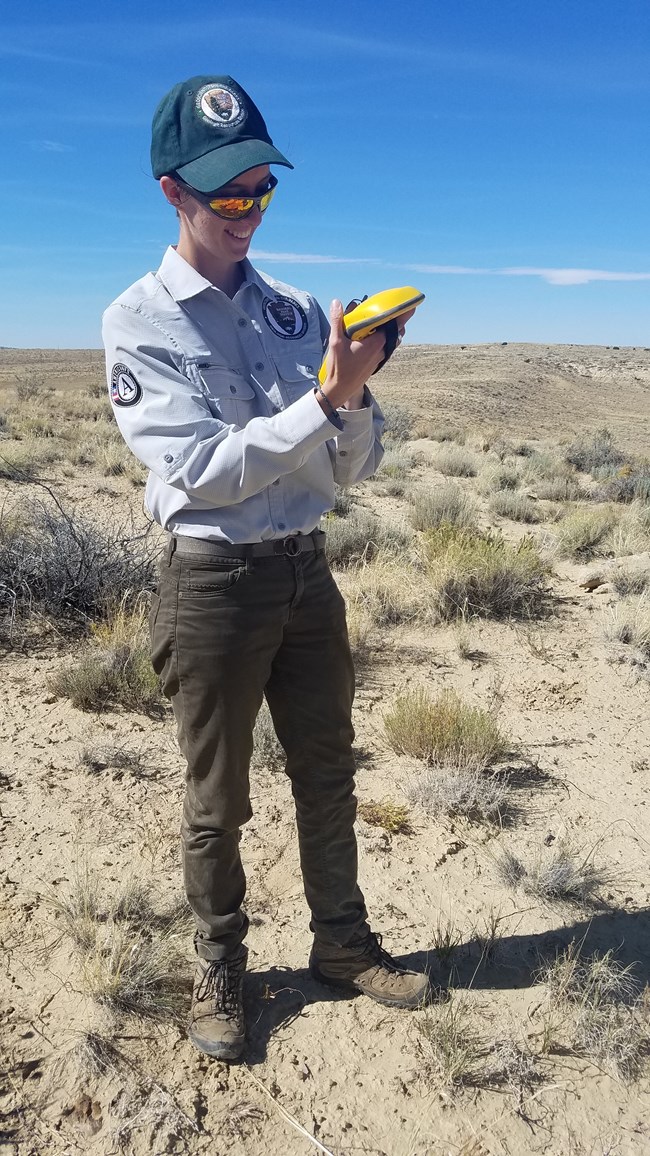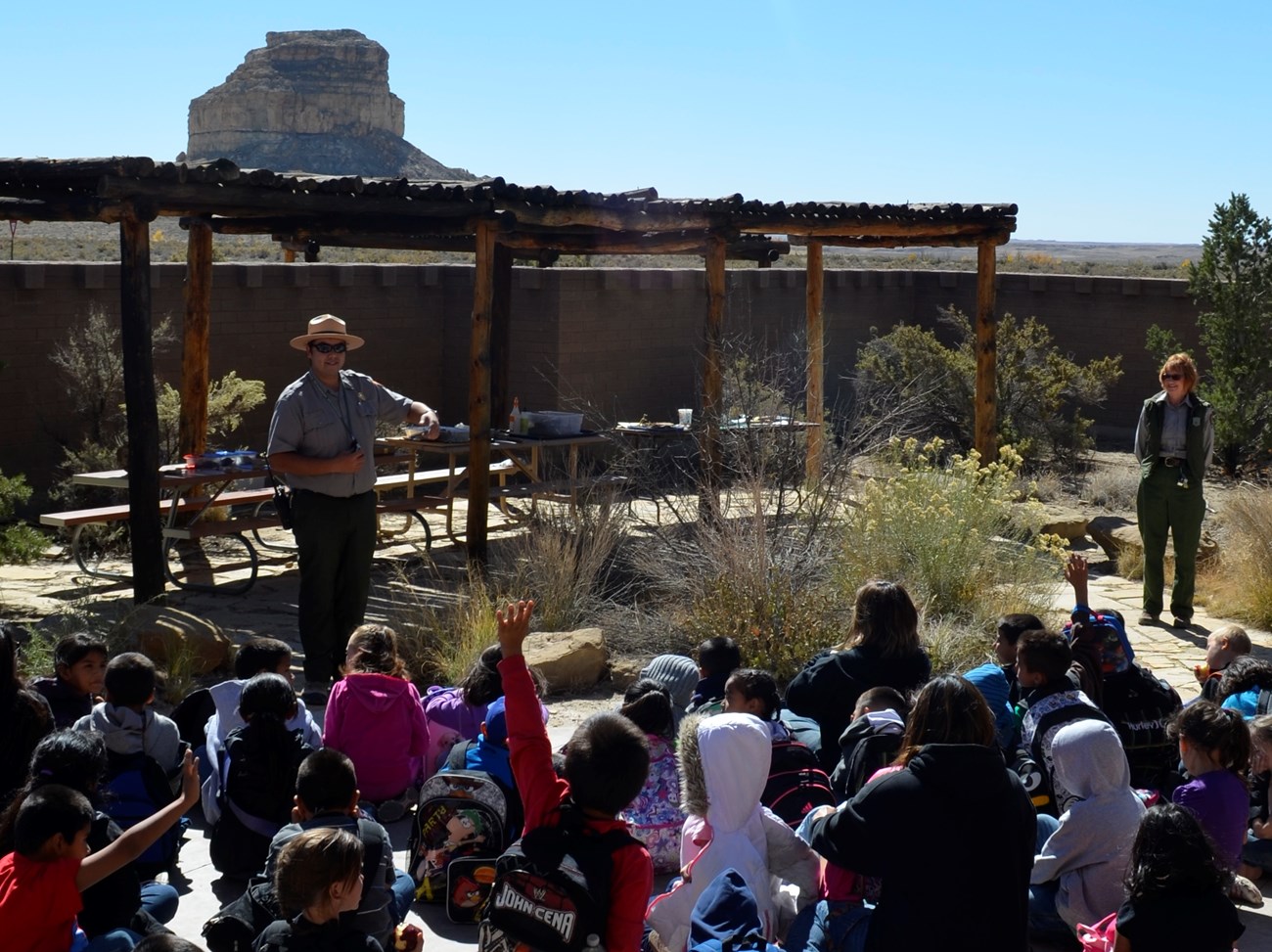Part of a series of articles titled Park Paleontology News - Vol. 12, No. 1, Spring 2020.
Article
Fossils in Focus: Using Photogrammetry and 3D Models to Highlight Recent Paleontological Discoveries at Chaco Culture National Historical Park

Cait Conley, Paleontology Intern, and Phil Varela, Paleontologist
Chaco Culture National Historical Park, New Mexico

NPS photo.
Introduction
Within the rocks and cliff walls that surround the monumental structures of Chaco Culture National Historical Park (CHCU) lie the remains of an ancient world that predates the Ancestral Puebloans by tens of millions of years. Fossils are prevalent in the American Southwest, and Chaco Canyon is no exception, despite the previously long-held belief that few fossils were present. Paleontologists since the late 19th century have been interested in fossils in the more well-known strata of the nearby Fruitland and Kirtland Formations in the San Juan Basin just north of Chaco Canyon. The fossil resources of CHCU remained relatively unknown and undocumented until recently, despite their close proximity to more intensively studied areas.
Paleontological investigations of Chaco Canyon began in the early 20th century with United States Geological Survey expeditions to the San Juan Basin (Reeside and Knowles 1924). Limited studies continued in conjunction with archaeological excavations by the University of New Mexico Field School (Vann 1931; Wood 1940). Decades later, Siemers and King (1974) were the first to attempt to characterize fossil assemblages in the canyon. These early reports focused heavily on marine invertebrate fossils, and since then, vertebrate fossils were known anecdotally by various scientists visiting the area. No research permits were granted by the park to study the vertebrate fossil assemblages despite submitted proposals by area paleontologists.
New Fossil Discoveries at Chaco
A renewed interest in paleontology in Chaco Canyon began when NPS volunteer Tom Lyttle documented vertebrate fossil localities in 1996 and 1998. By 2005, CHCU had formally initiated a baseline paleontological resource inventory, which continued every year from 2005 to 2018. During that time, more than 344 paleontological sites were documented, photographed, and mapped. In 2019, the first comprehensive Paleontological Resources Inventory of CHCU was completed, summarizing nearly 100 years of paleontological research (Varela 2019). Few parks have such reports, but for Chaco, this comprehensive document is now a foundational text that informs resource management, museum curation, law enforcement, tribal consultation, and interpretation.
The report reveals a rich and diverse group of Late Cretaceous (90–75 Ma) fossils that represent dynamic marine and terrestrial environments. The rock units within CHCU represent repeated transgressive (marine advance) and regressive (marine retreat) depositional cycles of the Western Interior Seaway, providing a unique opportunity to study the relationships between the terrestrial on-shore and marine off-shore environments, including numerous fossil specimens that have not yet been scientifically described.
Marine rock units contain the remains of abundant marine life, including bivalves, gastropods, cephalopods, echinoderms, sharks, bony fish, and marine reptiles. Invertebrate trace fossils and plant material, including impressions of woody debris and logs, are also preserved in the marine rocks. Terrestrial rock units contain the remains of abundant petrified trees and logs, several types of turtles and dinosaurs, and crocodiles, see Figure 1 below. More than 120 species of fossils have been reported from Cretaceous rocks at CHCU, the majority being fossil invertebrates from the Cliff House Sandstone. The abundance of undescribed fossils at CHCU offers an opportunity to discover and describe additional and new fossil taxa, aiding in the understanding of the evolution of life on Earth.
| Formation | Age | Fossils Within CHCU | Depositional Environment |
| Quaternary rocks and sediments (Qj, Qes, Qsw, Qn, Qnt, Qal) |
Pleistocene–Holocene | Primarily Holocene: Charcoal, wood, plant fragments from packrat middens, pollen, gastropods, salamanders, frogs, lizards, snakes, birds, shrews, rodents, rabbits, bats, canids, felids, ursids, bison, deer, elk, pronghorns, sheep, bone fragments, and latest Pleistocene-Holocene packrat middens | Alluvial, fluvial, eolian, landslide, and talus deposits. |
| Pictured Cliffs Sandstone (Kpc) |
Late Cretaceous (Campanian) | Bivalves, vertebrate bone fragments, and Invertebrate burrows | Coastal delta front, beach, and stream channel. |
| Lewis Shale (Kl) |
Late Cretaceous (Campanian) |
Petrified wood/plant fragments including a tree stump (possibly eroded from the Pictured Cliffs Sandstone), bivalves, gastropods, a tooth, a mosasaur bone fragment, bone and shell fragments, and invertebrate trace fossils | Offshore marine (deep water). |
| Cliff House Sandstone (Kch, Kchu, Kchwu, Kchwl, Kchm, Kchi,and Kchl) |
Late Cretaceous (Campanian) |
Gymnosperm and angiosperm wood including logs, woody debris impressions, reed molds, bivalves, ammonites, gastropods, echinoids, shark teeth, fish, mosasaurs, plesiosaurs, turtle bones, undetermined vertebrate bones, and invertebrate burrows (some in rock used as building stone) such as Ophiomorpha nodosa. | Barrier island, beach, nearshore marine (shallow water). |
| Menefee Formation (Kmf, Kmft, Kmfa, Kmfaj, and Kmfal) |
Late Cretaceous (Campanian) |
Gymnosperm and angiosperm wood and leaves, tree stumps, possible reed molds, coal (some worked into beads) and carbonaceous debris, amber pellets, bivalves, turtles, crocodilians, dinosaurs (theropods, hadrosaurids, and possibly ceratopsids), and termite burrows with fecal pellets. | Lowland swamp, lagoon, deltaic plain, river floodplain, and stream channel. |
| Crevasse Canyon Formation (Kcg and Kcda) |
Late Cretaceous (Coniacian-Santonian) |
Trace fossils | Lagoon, estuary, and beach |
Initial assessments of vertebrate skeletal remains indicate that any diagnostic elements may represent previously unknown species, especially within the Menefee Formation. Invertebrate species provide important biostratigraphic context for regional geologic correlation and the understanding of paleoenvironments of the Late Cretaceous. Fossil plants, especially the abundance of fossil trees at CHCU, may provide important information on the early evolution of angiosperm trees, which marks a significant shift of plant diversity on Earth.
Photogrammetry and 3D Models Make Fossils Accessible
In the fall of 2019, Chaco established a Geoscientist-in-Parks (GIP) position to work with the paleontology report and create educational and outreach materials that spread the word about Chaco’s little known paleontological resources. Collaborating with a regional team, including the authors of the report, visiting paleontologist Cait Conley brainstormed the desired goals and outcomes for interpretation, and created multiple products that showcase the rich and diverse history of Chaco. This included the development of interpretive and outreach materials about the park’s paleontology, including a landing page for Chaco’s website, 3D interactive fossil models, social media content, and informational guides for interpretive staff. Paleontological site monitoring and outreach efforts remain ongoing.

NPS photo.
Cait identified key fossil sites and worked with NPS Geological Resources Division staff Jack Wood to conduct photogrammetry, the process of turning two-dimensional photographs into interactive 3D models. Cait completed field visits to fossil localities to assess for the potential to tell stories that spark visitors’ curiosity and encourage them to imagine what life was like in the Late Cretaceous.
After selecting specimens, Cait coordinated a week of field photography and learned how to use a computer program to stitch the photographs into a 3 dimensional model. GIP experiences that feature 3D photography are valuable to both the intern, who gains useful skills, and the park the GIP serves, which holds a plethora of geological resources that are not accessible to the public.
After photographing, Cait wrote interpretive descriptions to accompany the interactive 3D models. As these images are added to the Geologic Resources page, they can be used to educate the public as well as preserve data related to the park’s paleontology. One example of this work can be found here.

NPS image by Jack Wood.
Another way to connect with visitors of Chaco is through the official Facebook page. The majority of Facebook followers are people who are already familiar with Chaco but may not necessarily know about its paleontology. Posts that highlight interesting fossils from the park with the tag #fossilfriday engage visitors in a measurable way. Cait began a series of #fossilfriday posts on the Chaco Facebook page in November and followers have tuned in to ask and answer questions, continuing the conversation. Another post prompted visitors to share their own fossil photos and have their questions answered by a visiting paleontologist. As of February 24, 2020, more than 3,384 engagements have been made through these posts. The most popular post reached more than 22,000 people.
Visitors to Chaco often see fossils while exploring the ruins or while on hikes. Shrimp burrows, bivalve shells, and ocean ripple marks certainly feel out of place in the arid desert scrubland that the park sits on today. Few people arrive with prior knowledge that fossils are found here, and discussions of fossils in ranger-led interpretive programs offers a completely new and eye-opening perspective for many visitors who may have never considered the geologic history of the canyon.

NPS photo.
The published survey report and subsequent outreach efforts are intended to make new information accessible and engage a variety of visitors, from expert paleontologists to people who have never heard of these fossils before. Additionally, raising awareness of fossil resources provides an opportunity to educate the public on stewardship and protection of fossils at Chaco and other national parks and public lands. Increased engagement allows visitors to have an active role in conservation by documenting their finds and leaving them where they are, and reporting them to park staff.
Related Links
References
- Reeside, J. B., Jr., and F. H. Knowlton 1924. Upper Cretaceous and Tertiary formations of the western part of San Juan Basin, Colorado, and New Mexico; Flora of the Animas Formation. U.S. Geological Survey, Washington, D.C. Professional Paper 134.
- Siemers, C. T., and N. R. King. 1974. Macroinvertebrate paleoecology of a transgressive marine sandstone, Cliff House Sandstone (Upper Cretaceous), Chaco Canyon, northwestern New Mexico. Pages 267–277 in C. T. Siemers, L. A. Woodward, and J. F. Callender, editors. Ghost Ranch. New Mexico Geological Society, Socorro, New Mexico. Guidebook, 25th Field Conference.
- Vann, R. P. 1931. Paleontology of the Upper Cretaceous of Chaco Canyon, New Mexico. Thesis. University of New Mexico, Albuquerque, New Mexico.
- Varela, P. J., V. L. Santucci, and J. S. Tweet. 2019. Chaco Culture National Historical Park: Paleontological resources inventory (non-sensitive version). Natural Resource Report NPS/CHCU/NRR—2019/1915. National Park Service, Fort Collins, Colorado. http://www.npshistory.com/publications/chcu/nrr-2019-1915.pdf
- Wood, L. 1940. Fossils of the Mesaverde Formation of Chaco Canyon, New Mexico. Chaco Culture National Historical Park Archive, Cultural Resource Management records, 7/9.1.1–135.
Last updated: March 10, 2020
